Advertisements
Advertisements
Question
If area of triangle is 35 square units with vertices (2, −6), (5, 4), and (k, 4), then k is ______.
Options
12
-2
−12, −2
12, −2
Solution
If area of triangle is 35 square units with vertices (2, −6), (5, 4), and (k, 4). Then k is 12, −2.
Explanation:
Given, the vertices of the triangle are (2, -6), (5, 4) and (k, 4);
`Delta` Area of = `Delta = 1/2 abs ((x_1,y_1,1),(x_2,y_2,1),(x_3,y_3,1))`
x1 = 2, y1 = 6, x2 = 5, y2 = 4, x3 = k, y3 = 4
`Delta` Area of `pm 35`
`pm 35 = 1/2 [2(4 - 4) + 6(5 - k) + k (120 - 4 k)`
`=> pm 35 = 1/2 [ 2 xx 0 + 6(5 - k) + 1 (20 - 4 k)]`
`=> pm 70 = 6(5 - k) + 20 - 4 k`
`=> pm 70 = 30 - 6 k + 20 - 4 k`
`=> pm 70 = 50 - 10 k`
`=> pm 70 = 5 - k`
7 = 5 - k
⇒ k = 5 - 7
k = -2
-7 = 5 - k
⇒ - 12 = - k
⇒ k = 12
अत: k = 12, -2
APPEARS IN
RELATED QUESTIONS
If the points A(−2, 1), B(a, b) and C(4, −1) are collinear and a − b = 1, find the values of a and b.
Prove that the points (2, – 2), (–3, 8) and (–1, 4) are collinear
Find the area of the triangle whose vertices are: (2, 3), (-1, 0), (2, -4)
In each of the following find the value of 'k', for which the points are collinear.
(8, 1), (k, -4), (2, -5)
median of a triangle divides it into two triangles of equal areas. Verify this result for ΔABC whose vertices are A (4, - 6), B (3, - 2) and C (5, 2).
Find the area of a triangle with vertices at the point given in the following:
(1, 0), (6, 0), (4, 3)
The area of a triangle is 5 sq units. Two of its vertices are (2, 1) and (3, –2). If the third vertex is (`7/2`, y). Find the value of y
Find the area of the following triangle:
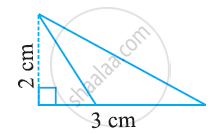
ΔABC is right angled at A (see the given figure). AD is perpendicular to BC. If AB = 5 cm, BC = 13 cm and AC = 12 cm, Find the area of ΔABC. Also find the length of AD.

ΔABC is isosceles with AB = AC = 7.5 cm and BC = 9 cm (see the given figure). The height AD from A to BC, is 6 cm. Find the area of ΔABC. What will be the height from C to AB i.e., CE?
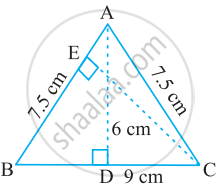
The vertices of ΔABC are (−2, 1), (5, 4) and (2, −3) respectively. Find the area of the triangle and the length of the altitude through A.
Prove that the points (a, b), (a1, b1) and (a −a1, b −b1) are collinear if ab1 = a1b.
prove that the points A (7, 10), B(-2, 5) and C(3, -4) are the vertices of an isosceles right triangle.
Show that the points (-3, -3),(3,3) and C (-3 `sqrt(3) , 3 sqrt(3))` are the vertices of an equilateral triangle.
A(7, -3), B(5,3) and C(3,-1) are the vertices of a ΔABC and AD is its median. Prove that the median AD divides ΔABC into two triangles of equal areas.
Show that the following points are collinear:
(i) A(2,-2), B(-3, 8) and C(-1, 4)
For what value of y, are the points P(1, 4), Q(3,y) and R(-3, 16) are collinear ?
Find the value of x for which the points (x, −1), (2, 1) and (4, 5) are collinear ?
If the area of triangle ABC formed by A(x, y), B(1, 2) and C(2, 1) is 6 square units, then prove that x + y = 15 ?
The coordinates of the point P dividing the line segment joining the points A (1, 3) and B (4, 6) in the ratio 2 : 1 are:
If the points A (x, y), B (3, 6) and C (−3, 4) are collinear, show that x − 3y + 15 = 0.
In ☐ABCD, l(AB) = 13 cm, l(DC) = 9 cm, l(AD) = 8 cm, find the area of ☐ABCD.
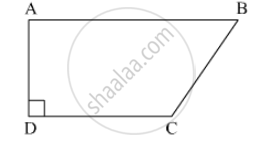
Using integration, find the area of the triangle whose vertices are (2, 3), (3, 5) and (4, 4).
What is the area of a triangle with base 4.8 cm and height 3.6 cm?
Find the area of the following triangle:
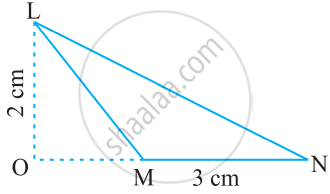
In ∆PQR, PR = 8 cm, QR = 4 cm and PL = 5 cm. 
Find:
(i) the area of the ∆PQR
(ii) QM.
If the co-ordinates of the vertices of an equilateral triangle with sides of length ‘a’ are (x1, y1), (x2, y2), (x3, y3), then `|(x_1, y_1, 1),(x_2, y_2, 1),(x_3, y_3, 1)|^2 = (3"a"^4)/4`
Show that the ∆ABC is an isosceles triangle if the determinant
Δ = `[(1, 1, 1),(1 + cos"A", 1 + cos"B", 1 + cos"C"),(cos^2"A" + cos"A", cos^2"B" + cos"B", cos^2"C" + cos"C")]` = 0
The area of the triangle ABC with the vertices A(-5, 7), B(-4, -5) and C(4, 5) is ______.
Find the coordinates of the point Q on the x-axis which lies on the perpendicular bisector of the line segment joining the points A(–5, –2) and B(4, –2). Name the type of triangle formed by the points Q, A and B.
The area of ∆ABC is 8 cm2 in which AB = AC = 4 cm and ∠A = 90º.
The area of a triangle with vertices A, B, C is given by ______.
Area of triangle MNO in the figure is ______.

In the given figure, if PR = 12 cm, QR = 6 cm and PL = 8 cm, then QM is ______.

Triangles having the same base have equal area.
Ratio of the area of ∆WXY to the area of ∆WZY is 3:4 in the given figure. If the area of ∆WXZ is 56 cm2 and WY = 8 cm, find the lengths of XY and YZ.
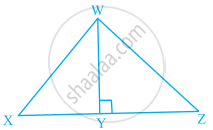
Using determinants, find the area of ΔPQR with vertices P(3, 1), Q(9, 3) and R(5, 7). Also, find the equation of line PQ using determinants.
